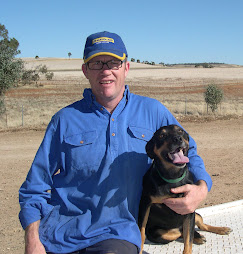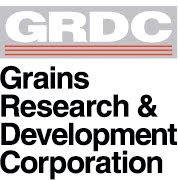Bob, Newton and I
We caught up with Bob & Newton at the Lethbridge Agricultural Research Centre. They are looking after the long term no-till trials. A very interesting note from Newton was that they have found the organic matter is broken down a lot quicker in conventional tilled soils than No-Till, but that was faster than in Zero-till as the turning of the soil allows oxygen to enter the soil. Respiration occurs at high rates when oxygen is plentiful. The soils, when they are initially tilled, give a large release of nitrogen and very little during the season. On the other hand No-till and progressively Zero-Till give a more even distribution of Nitrogen and other nutrients release during the season. This would be good for crops in higher rainfall areas where growth is needed to be moderated to maximise grain yield rather than early vegetative growth.
Gopher Trap - They Make a Mess of Trials
A very interesting couple of trials were the Scalping and the Trucking ones. The scalping trials were a series of plots that had the top soil removed and then had to be remediated. A number of treatments were used. The top treatment was cattle manure from feedlots and the second was inorganic fertilizer. Both of these gave a lot of nutrients which allow for large amounts of biomass to be produced and therefore added tosoil. Trucking was an extra trial on top of the scalping one. The top soil was removed and then replaced with all types of soils from around Canada. These were put on the scalped ones. The trial was to see the outcome of having different soils but the same climate. The trials are being written up at the moment. They have been conducted over 40 years.Another project Bob ran, was based around inputs. He looked at the inputs farmers can use. It firstly ran for 4 years with treatments of High critical inputs (Full chemical use) vs. Low inputs (Knockdowns only). High yielding varieties vs. Low yielding varieties. High seeding rates vs. Low seeding & Tall genetics vs. Dwarf genetics. In the first and second years there were no problems and the trials showed no clear choices, but in the 3rd and 4th years some of the systems collapsed namely the ones with no fertiliser and not full weed control. In the 5th year what really showed out were the plots good genetics, robust seeding rates with full weed control and the best fertility. I think this is a no brainer. The results were put through an economic model and it showed that it is best for the farmer to spend his money on weed control firstly and secondly on fertiliser.
Bob has had some farmers who viewed the end results ask him to now see how long in time and in money it would take to bring these plots back into good health. I feel this would benefit farmers to assess some land they may want to buy or rent. It also gives them a guide to help them if there is a cash squeeze for a year or two.
Newton has been following the trial and assessing biomass numbers. When high rates of Nitrogen were applied the biomass numbers was a negative effect for a short period. The reverse happened when the herbicides were applied at label rates. He said he would send on a full report.
In all of their trial work they have found that Canola has the highest need for Nitrogen. (Yields of 5-6t are not uncommon). They are trialling at a number of sites across the Canadian prairies to test canola after a number of different legumes, cereals and even Canola. The treatment overlayed is different Nitrogen fertilizer rates of 0,25,50,75,100 kg N/ha. They are doing a replicate of this with Wheat. Newton is looking at the effect these treatments have on the biomass of the soil.






No comments:
Post a Comment